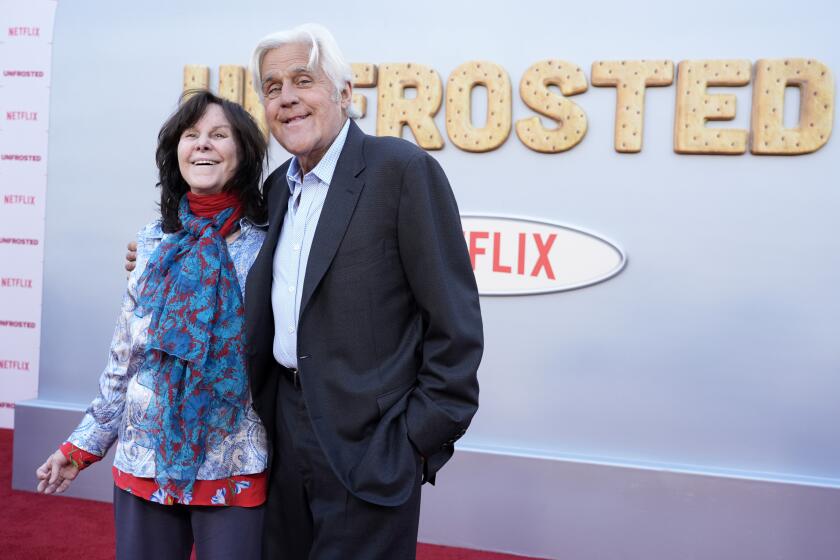Oh, Jackie! Now What? : The Onassis Sale Has Raised the Stakes
- Share via
NEW YORK — The last word on the Jacqueline Kennedy Onassis auction probably should have been spoken after the tents came down on York Avenue and the media circus fled Sotheby’s for the next big story.
But curiosity remained in the art world and beyond: What was that all about?
The frenzy, the mobs, the seemingly sane people paying hundreds of times real-world value for things like a scuffed-up stool, a 45-rpm record or a copy of a Dr. Spock baby book that belonged to Onassis--it must add up to something more than another $34 million for her kids, Caroline and John.
Auction house insiders still are not quite settled on whether this event in late April was an aberration or a moment that somehow warped the auction world forever. If nothing else the cognoscenti agree that celebrity auctions will probably receive more attention in the future from the press and public.
“The experience was a dramatic way to educate the public about auctions,” said David Redden, senior vice president of Sotheby’s. “It set a new standard for the kind of excitement that a sale could create and made Sotheby’s that much more approachable to large numbers of people, thus bringing a lot of new blood into the market.”
Patricia Hambrecht, head of rival Christie’s, said it is too early to determine if the Onassis sale would have a tangible impact.
“For example, in our American painting sale, our best ever, 20% of our buyers were new to us,” she said. “And we saw a lot of people spend six figures when before that they spent only in the low five figures. Did the publicity around the Onassis sale help? No, I don’t think so, but who knows?”
There were several “firsts” at the Onassis auction.
It was the first time an auction house printed such a thick catalog--584 pages--and sold so many copies--110,000. Sotheby’s also broke precedent by not putting Onassis’ photograph on the cover.
“It’s unusual for us to be quite so discreet as to simply have a name on the front,” Redden said. “But it seemed to conform to the dignity of this sale.” Discreet, maybe, but announced at a giant news conference--dramatizing Sotheby’s struggle between maintaining an aura of dignity and shameless marketeering.
Another first was the 40,000 people who flocked to the pre-auction exhibition and the 125,000 who actually put in bids. For the first time, Sotheby’s had to run a lottery to select who could attend while the rest were in touch by phone.
Sotheby’s wager in taking on this mammoth event, employing nearly all its 550 staff on this side of the Atlantic, seemed to be that it would pay off by maximizing the company’s name recognition and familiarizing new people around the world with the auction process.
(It may seem outlandish, for example, that Onassis’ chipped and discolored candlesticks valued at about $350 sold for $35,000, but even that price is pocket change compared to what collectors spend at chic evening auctions of Impressionist and modern art.)
Indeed, Redden said Sotheby’s has been deluged since the Onassis sale by calls from new clients, both potential buyers and sellers.
“We could have an entire sale of just rocking chairs,” said the very British Redden, adding in an understated yet distinctly ironic tone, “Some people do not understand the concept of ‘provenance.’ One does have to educate people on that.”
By “provenance” he means that the reason people paid a hefty $453,000 and $442,500 for two Kennedy rocking chairs had more to do with who sat in them than the quality of their wood or design. Which ultimately was the bottom line of the Jackie sale: If the Kennedys touched it, somebody wanted it--at any inflated price.
As an example of how Sotheby’s is hoping to use its newly expanded mailing list, Redden described a couple who bid unsuccessfully for a book inscribed to President Kennedy by Israeli legend David Ben Gurion. The head of Sotheby’s Judaica department promptly sent several underbidders, including the couple, a catalog for an upcoming sale of Judaica.
“This couple was so excited they made a special trip to New York to have a look at the items and they intend to bid,” Redden said. “So people whose names we didn’t even know before we now know and we certainly have every intention of keeping track of them and letting them know what we can do for them.”
Bruce Wolmer, editor of Art and Auction magazine, speculated that celebrity auctions could become increasingly important as post-baby boomer generations come into money with a different education and sets of cultural references.
“Jackie raises the possibility that these type of pop culture oriented celebrity sales will bulk relatively larger in auction house bottom lines,” Wolmer said. He was careful to add that he didn’t think celebrity sales could become as important to the auction houses as the art markets.
Wolmer and others in the art trade are also concerned that some important distinctions between “works of tested quality and objects of mere sentiment” may have been lost on the huge audience that followed the Onassis auction on the evening news.
Wolmer wrote in an editorial: “In a culture in which the line separating high and low, the real and the virtual, is being effectively eroded, Jackie [the sale] demonstrates that the art world is no more immune to such fierce downward pressures than anyone else.”
Certainly, the inflation of values because of the person who owned it is not a new concept. Sotheby’s, founded in 1744, hawked Napoleon’s possessions in the 19th century. More recently, Judy Garland’s ruby slippers went at auction for $100,000, and a pair of tattered $20 ballet slippers worn by Rudolf Nureyev brought $7,000.
Insiders, in fact, find it ironic that items sold in April weren’t exactly Onassis’ most precious goods. There were a few paintings and baubles the art world coveted--and thus were assessed before the sale at close to their value. But the rest was, well, sloppy thirds.
Her children got first pick and then before the auction they made a “pretty substantial gift” to the JFK Library / Foundation in Boston, said representative Shelley Sommer.
“The most historically significant items are here,” Sommer said.
But if Sotheby’s wasn’t peddling her best stuff, the public still craved whatever was offered, and the fever spread to auction houses all over this city and elsewhere.
The week of the Onassis sale, the William Doyle Galleries in Manhattan sold a simple black silk satin dress designed by Charles James for $49,500, a record price for any couture dress auctioned in the United States. After the high bid was made, the audience gasped and auctioneer Jeanne Mournet said, “And Jackie O never even touched it!”
But William Doyle, among the originators of celebrity auctions, has received many calls since the Onassis sale from people with other items related to her. One caller asked how much a photograph of himself with Onassis would get at auction; another had a scarf that once belonged to her and hoped to make money off it.
Mournet, a senior vice president at William Doyle, explained, however, that even the most valuable Onassis item could never sell as well as it might have at that auction.
“If someone were to reconsign to Sotheby’s something bought at the Jackie O sale and it was put in with auction of memorabilia of lots of different people, it could never hope to get the same price. You can’t re-create the excitement of an auction very easily.”
Mournet also said that one sale might also have set unreal expectations for the future.
“The Jackie sale raised the stakes,” Mournet said. “Everyone will always wonder, might it be, could it be, the one that out-glitzes Jackie O?”
More to Read
The biggest entertainment stories
Get our big stories about Hollywood, film, television, music, arts, culture and more right in your inbox as soon as they publish.
You may occasionally receive promotional content from the Los Angeles Times.










